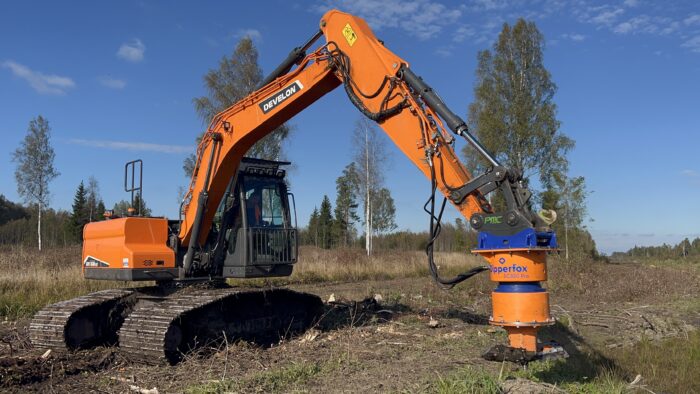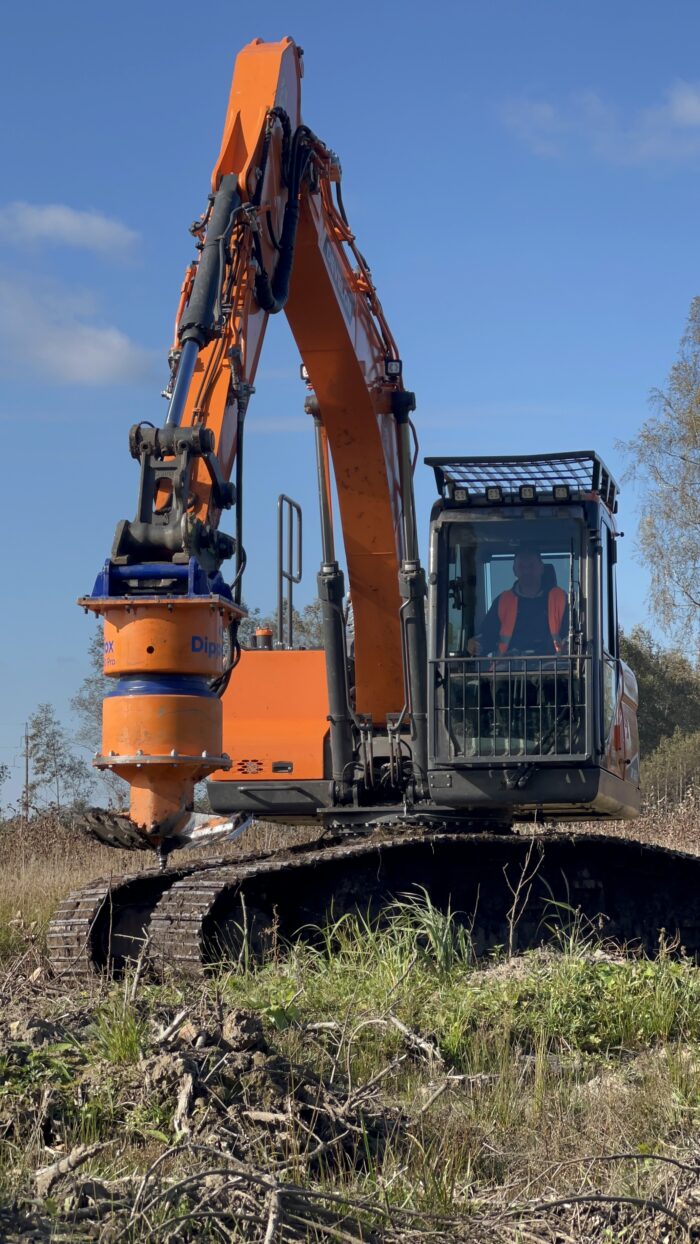Pulling a stump with a bucket tears the root ball and topsoil, leaving cavities and churned subsoil that hold water. In wet or soft conditions, that disturbance turns into rutting and puddling, degrading bearing capacity and increasing the odds that follow-on equipment gets stuck (“bogged”). Forestry and construction guidance consistently ties machine disturbance to rutting, compaction, and instability—exactly the conditions that trap machines and slow projects.
Industry safety and training resources further note that soft or disturbed ground is a primary factor in excavators sinking, recommending mitigation to avoid “unstuck” operations later. In short: the more you churn the soil now, the more likely your graders, dumpers, or pavers get delayed later.
Why a Dipperfox Stump Drill for Excavators Is Different
1. Vertical Drilling = Minimal Soil Disturbance
Dipperfox’s approach is top-down: drill and crush the stump into chips in situ, leaving roots to decompose underground and keeping the surrounding soil structure intact—no big holes, no torn turf, no mess. That means the ground retains its carrying capacity for second-wave equipment.
2. Proven Speed & Throughput
The Dipperfox SC850 Pro can clear a stump typically in 20–120 seconds, with broader claims of 5–10× faster than traditional methods. Faster stump cycles = fewer excavator hours and fewer machine moves, another hidden driver of productivity.
3. Smart Power: Automatic 2-Speed Gearbox
The patented mechanism switches between speed and torque as wood density changes, maintaining bite without operator over-fiddling. Result: consistent progress, less stalling, and less wear.
4. Cleaner Sites, Lower Risk
With drilling, debris is mulch-like chips (usable onsite), and there’s far less flying material than high-RPM discs—safety, visibility, and cleanup all improve.

Head-to-Head: Digging vs. Disc Grinding vs. Dipperfox Drilling
| Criteria | Digging/Uprooting | Disc-Type Grinder | Dipperfox Vertical Drill (Winner) |
|---|---|---|---|
| Soil disruption | High—holes, churned subsoil, rutting risk | Moderate—surface chipping and spoil | Low—drills stump in place, preserves bearing capacity |
| Risk to 2nd-wave machines | High—soft/rutted ground bogs equipment | Moderate | Low—site stays trafficable |
| Typical cycle time | Long, variable by root ball/soil | Moderate | Fast—manufacturer cites 20–120s; 5–10× faster overall |
| Cleanup/hauling | High (root balls, spoil) | Chip management | Chips remain as mulch; minimal haul-off |
| Safety & visibility | Bucket swings, unstable cavities | High-RPM, flying debris | Lower RPM style; better visibility, less mess |
Field Math: Throughput & Downtime Avoidance
Assume 200 stumps:
- Digging: even at 3-5 minutes each (optimistic), that’s 10-16 hours of bucket work – plus landfilling and transportation costs, backfilling and grading.
- Dipperfox: 20-120 sec each => 1.1-6.7 hours of drilling time, plus brief finishing.
The delta easily frees a day+ of machine time and slashes exposure to weather windows where soft ground bogs machines.
Pair the speed with stable ground, and you also avoid the hidden cost of recoveries, mats, or rework when a dozer or dumper sinks. Industry guidance underscores that avoiding soft/disturbed ground is the best prevention.
Spec Snapshot (SC850 Pro)
Carrier: 14–30 t excavators
Smart gearbox: auto 2-speed torque/speed management
Performance: multiple-times faster than conventional methods; 5–10× faster claims appear in official/user documentation.

Real-World Proof Points
Dipperfox details how digging damages turf/roots and turns sites muddy—machines get stuck—while vertical drilling preserves ground carrying capacity.
Dipperfox documents construction-site savings and time wins from switching to vertical drilling.
Ireland (Monasterevin) — 106 acres reclaimed to “farmland-ready” in ~3.5 months.
On a long-neglected former Christmas tree plantation, the contractor centered the process around the Dipperfox 850 Pro and delivered a trafficable, level result on an aggressive timeline. The narrative connects speed of removal with minimal ground disruption, which keeps second-wave machinery productive instead of getting bogged.
France — poplar silviculture expert validates drilling on-farm.
Poplar grower Jérome Bournaud (plywood/furniture supply) invited a dealer demo and shared first impressions after seeing stumps removed on his own fields. The testimonial underscores why drilling is attractive for production forestry sites that need fast turnover without destroying soil structure that later equipment depends on.
New Zealand forestry conversion — two carriers, one outcome: fast destumping, clean ground.
Robur Hire tested two Dipperfox 850 Pro units on a rugged farm block—one on a 14-ton and one on a 22.5-ton excavator. Operators reported clearing “far more stumps” than they would by digging or conventional grinding, while the vertical drill approach left a tidy, trafficable surface (no crater, no mud bowl) for follow-on machines. The article also highlights 43,000 Nm first-gear torque and the auto 2-speed gearbox that keeps progress steady in mixed conditions.
Ready to keep the ground solid for your second-wave machines—and finish faster? Request a Dipperfox demo or offer and compare cycle time, fuel, and recovery events against your current method.




 Share
Share